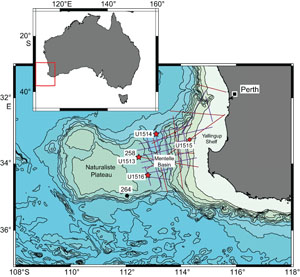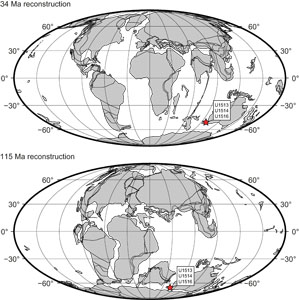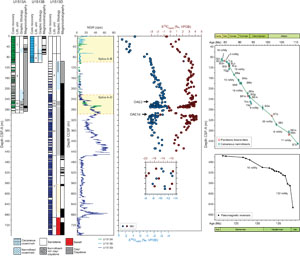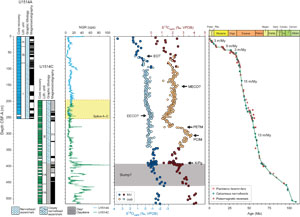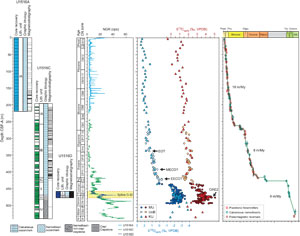Hobbs, R.W., Huber, B.T., Bogus, K.A., and the Expedition 369 Scientists
Proceedings of the International Ocean Discovery Program Volume 369
publications.iodp.org
Data report: Cenozoic and Upper Cretaceous bulk carbonate stable carbon and oxygen isotopes from IODP Expedition 369 Sites U1513, U1514, and U1516 in the southeast Indian Ocean1
Kirsty M. Edgar,2 Kenneth G. MacLeod,3 Taka Hasegawa,4 Emma M. Hanson,2 Ian Boomer,2 and Nicola Kirby2
1 Edgar, K.M., MacLeod, K.G., Hasegawa, T., Hanson, E.M., Boomer, I., and Kirby, N., 2022. Data report: Cenozoic and Upper Cretaceous bulk carbonate stable carbon and oxygen isotopes from IODP Expedition 369 Sites U1513, U1514, and U1516 in the southeast Indian Ocean. In Hobbs, R.W., Huber, B.T., Bogus, K.A., and the Expedition 369 Scientists, Australia Cretaceous Climate and Tectonics. Proceedings of the International Ocean Discovery Program, 369: College Station, TX (International Ocean Discovery Program). https://doi.org/10.14379/iodp.proc.369.206.2022
2 School of Geography, Earth and Environmental Sciences, University of Birmingham, United Kingdom. Correspondence author: k.m.edgar@bham.ac.uk
3 Department of Geological Sciences, University of Missouri, USA.
4 Institute of Science and Engineering, Kanazawa University, Japan.
Abstract
International Ocean Discovery Program (IODP) Expedition 369 recovered pelagic sediments spanning the Albian to Pleistocene at Sites U1513, U1514, and U1516. The cores provide an opportunity to determine paleoclimatic and paleoceanographic dynamics from a hitherto poorly sampled mid-high-latitude location across an ~110 My interval, beginning during the Cretaceous supergreenhouse when eastern Gondwana was still largely assembled and ending during the modern icehouse climate after the final breakup of Gondwana. Here we present ~650 bulk carbonate carbon and oxygen stable isotope data points and plot them alongside shipboard data sets to present a first broad documentation of chemostratigraphic data that reveal the stratigraphic position of key climatic transitions and events at Sites U1513, U1514, and U1516. These records show a pronounced long-term δ13C decrease and δ18O increase from the Albian/Cenomanian through the Pleistocene. Superimposed on this long-term trend are transient δ13C and δ18O events correlated with Oceanic Anoxic Event 2, peak Cretaceous warmth during the Turonian, Santonian to Maastrichtian cooling, the Cretaceous/Paleogene boundary, the Paleocene/Eocene Thermal Maximum, the Early Eocene Climatic Optimum, the Middle Eocene Climatic Optimum, and the Eocene–Oligocene transition. Recognizing these isotopic events confirms and refines shipboard interpretations and, more importantly, demonstrates the suitability of Sites U1513, U1514, and U1516 for future high-resolution paleoceanographic works aimed at illuminating the links between tectonic and oceanographic dynamics and global versus local environmental changes.
1. Introduction
A major objective of International Ocean Discovery Program (IODP) Expedition 369 was to investigate the evolution of Cretaceous and Cenozoic climate and ocean dynamics at the mid-high southern latitudes during the final breakup phase of the last connected remnants of the supercontinent Gondwana (Huber et al., 2019a). In addition to spanning the time of final rifting of Gondwana, this interval also encompasses profound climatic, oceanographic, and biotic reorganization from the hot greenhouse conditions of the Turonian to the onset of the modern icehouse climate state and establishment of modern oceanographic and climate dynamics during the Neogene (e.g., Batenburg et al., 2018; Cramer et al., 2011; Huber et al., 2018; MacLeod and Huber, 1996; Voigt et al., 2013; Westerhold et al., 2020). Expedition 369 sites are particularly important because they fill a key gap, both geographic and temporal. There are few records available from the mid-high southern latitudes that span this entire interval of time, and among these records, cores from nearby Kerguelen Plateau sites are the only other records from the Indian Ocean (Schlich, Wise, et al., 1989).
IODP Sites U1513, U1514, and U1516 were drilled to recover long-term, stratigraphically continuous and expanded pelagic claystones and carbonates of the upper Lower Cretaceous through Cenozoic sediment records from the Mentelle Basin off the coast of Western Australia (Figure F1; Huber et al., 2019a). These sites were situated at high paleolatitudes of ~60°S in the Cretaceous and migrated north to their present midlatitude position (~34°S) throughout the Cretaceous and Cenozoic as a result of rifting between Australia and Antarctica. Rifting culminated in the creation of the Tasman Gateway and an open-ocean connection south of Australia between the Pacific and Indian Oceans (Figure F2).
Here we present new and published (Petrizzo et al., 2021, 2022; Vahlenkamp et al., 2020) Cretaceous and Cenozoic bulk carbonate carbon and oxygen stable isotope (δ13C and δ18O) records from Sites U1513, U1514, and U1516, which were cored during Expedition 369 (Figure F1). This chemostratigraphic data set provides an important empirical framework constraining the location of key intervals of environmental change, which should facilitate future sampling for high-resolution studies, including astrochronological work, that will ultimately help to better understand the relationship between tectonic and environmental changes in the high southern latitudes.
2. Materials and methods
2.1. Site description
Site U1513 (33°47′S, 112°29′E; 2788 m modern water depth) is located in the west central portion of the Mentelle Basin (Figure F1; Huber et al., 2019b). Site U1513 is ~1 km east-northeast of Deep Sea Drilling Project (DSDP) Site 258, at which the Cretaceous section was spot cored in the 1970s (The Shipboard Scientific Party, 1974). Data are reported for ~460 m of deep-sea pelagic sediments ranging from the late Aptian to Pleistocene and 230 m of Early Cretaceous volcaniclastic sandstone from Holes U1513A and U1513D. No data were collected for Hole U1513B, which was cored to fill coring gaps present in Hole U1513A. Hole U1513C was reserved for optically stimulated luminescence study, and Hole U1513E was drilled through the sedimentary sequence to maximize time for coring basaltic basement.
Cenozoic sediments at Site U1513 are calcareous ooze with common sponge spicules. Recovery of this interval was near 100% (Figure F3). Recovery dropped to ~40% for Upper Cretaceous calcareous ooze (Cenomanian–Santonian), likely due to the presence of silicified layers, but recovery improved to ~75% for the volcaniclastic sandstones (Early Cretaceous) and overlying pelagic mudstones (late Aptian–Cenomanian) (Huber et al., 2019b). Shipboard splices were developed for Holes U1513A and U1513B and for the Cenomanian/Turonian boundary interval between Holes U1513A and U1513D. Estimated sedimentation rates are quite high in the older portions of the volcaniclastic sandstone unit (>100 m/My) but drop to 10 m/My or less toward the top of that lithostratigraphic unit. Sedimentation rates calculated for the pelagic intervals generally range between 10 and 20 m/My.
Site U1514 (33°7′S, 113°5′E; 3838 m modern water depth) was the most northerly and deepest site drilled in the Mentelle Basin during Expedition 369 (Figure F1; Huber et al., 2019c). Approximately 500 m of deep-sea sediments were recovered from two holes (U1514A and U1514C) at this site that together span the Pleistocene to Albian. Hole U1514B was reserved for optically stimulated luminescence study. It was not sampled and thus is not considered further here.
Site U1514 sediments are predominantly calcareous oozes and chalks with increasing biosiliceous grains and clay content downcore such that clay or claystones dominate the Cretaceous sequence (Figure F4). Recovery was close to 100% in Hole U1514A but decreased to 65% in Hole U1514C (Huber et al., 2019a), and it was possible to develop a shipboard splice for Holes U1514A and U1514C where they overlapped in the early middle Eocene (Huber et al., 2019c). Proposed tie points between the cores were refined by a postcruise high-resolution X-ray fluorescence (XRF) study and an astrochronology developed between ~40 and 56 Ma (Vahlenkamp et al., 2020). Sedimentation rates are relatively low for the deep sea, with rates of ~13–15 m/My in the Upper Cretaceous through Eocene decreasing to 3–9 m/My in the Oligocene and Neogene (Figure F3).
Site U1516 (34°2′S, 112°47′E; 2675 m modern water depth) was drilled in the southern central Mentelle Basin (Figure F1; Huber et al., 2019d). Four holes (U1516A–U1516D) were drilled at the site, with Holes U1516A and U1516C providing a record spanning the Holocene to Cretaceous. As at Site U1514, cores recovered from Hole U1516B were reserved for optically stimulated luminescence study and are not discussed here. Holocene to Turonian sediments are predominantly calcareous oozes/chalks transitioning to claystone across the Cenomanian/Turonian boundary (Figure F5). Albian–Cenomanian sediments are calcareous clays and claystones. Recovery was excellent in Hole U1516A (>100%) but significantly poorer in Hole U1516C (~60%). There was insufficient overlap of recovered sediments in Holes U1516A and U1516C to create a splice. Hole U1516D was drilled with the focused goal of recovering a second copy of the Cenomanian/Turonian boundary that was cored in Hole U1516C. An ~19 m thick sequence of sediments spanning the Cenomanian/Turonian boundary was recovered in Hole U1516D and correlated to Hole U1516C on board the ship (Huber et al., 2019d). Shipboard age control (Figure F5) indicates sedimentation rates of ~8 m/My in the Cretaceous through Paleogene increasing to ~18 m/My in the Neogene and punctuated by hiatuses in the Oligocene–Miocene and Paleocene–Upper Cretaceous.
2.2. Sample preparation and stable isotope analyses
A total of 192 samples, including both 2 cm3 samples collected for bulk isotopic studies as well as residues from samples for shipboard carbonate analyses from Core 369-U1513A-1H through Section 50X-1 and Sections 369-U1513D-6R-1 through 54R-4, were used to document trends in bulk carbonate isotopes at Site U1513 (Table T1). Of these bulk carbonate δ13C and δ18O analyses, 145 analyses are new in this study and 47 analyses were presented in Petrizzo et al. (2022). Sampling density was typically one sample per core for most of the section with increased sampling density in the intervals predicted to span oceanic anoxic events (OAEs).
A total of 335 samples (2 cm3) were taken from Cores 369-U1514A-1H through 31X and 369-U1514C-3R through 35R (Table T2). These samples were taken at regular intervals and do not follow the shipboard splice. Sample spacing varied but was approximately two samples per core in Holes U1514A and U1514C, with increased sampling of one sample per core section between Cores 369-U1514A-12H and 13X and between Cores 369-U1514C-2R and 19R corresponding to the Paleogene. The samples falling between the inferred Middle Eocene Climatic Optimum (MECO) and the Paleocene/Eocene Thermal Maximum (PETM) (~141–282 m core depth below seafloor, Method A [CSF-A]) at Site U1514 were presented in Vahlenkamp et al. (2020).
A total of 121 samples were taken from Cores 369-U1516A-1H through 29F and 369-U1516C-7R through 40R (Table T3). Sample spacing was one sample per core in the oldest and youngest intervals, with increased sampling of three to five samples per core in the Paleogene where sedimentation rates declined based on the shipboard age model (Huber et al., 2019d). The presented record is supplemented with 269 bulk carbonate δ13C and δ18O analyses spanning the Cretaceous from Petrizzo et al. (2021).
Bulk carbonate sample preparation followed standard protocols, with material first dried in a low temperature oven overnight (<50°C). For analysis, either samples were milled from pieces of the dried bulk sediment with a low speed drill or a portion of the bulk sample was ground into a fine powder using an agate mortar and pestle to homogenize the sample. Regardless, between ~40 and 300 µg of powder was used for each stable isotope analysis.
Bulk carbonate stable isotope analyses were carried out at three different laboratories: the Geological Mass Spectrometry (GEMS) facility at the University of Birmingham (UoB), United Kingdom; MacLeod's laboratory at the University of Missouri (MU), United States; and the Laboratory of Evolution of Earth Environment at Kanzawa University (KU), Japan. All data from Site U1513 and the low-resolution Cenozoic–Cretaceous record from Site U1514 were generated at MU on a Thermo Finnigan DeltaPlus isotope ratio mass spectrometer using a Kiel III carbonate device to generate and purify the analyte. Analytical precision in the MU laboratory was 0.03‰ and 0.06‰ (1σ) for δ13C and δ18O values, respectively, based on replicate analyses of the standard NBS-19. The low-resolution Cenozoic–Cretaceous record at Site U1516 was analyzed at KU. Powdered samples were dried overnight and then weighed (~0.3 mg each). Analyses were conducted on a Thermo Fisher GasBench II, and the gas was introduced and analyzed by a Thermo Fisher Delta V Advantage mass spectrometer. The reference standard NBS-19 (δ18O = −2.20‰; δ13C = +1.95‰) was analyzed twice daily and used for international calibration. Laboratory standard carbonates were analyzed more often to check the stability of the machine. Analytical precision of the isotopic measurements was <0.1‰ for both δ13C and δ18O values during the analyses on all samples studied. Higher resolution samples from the Paleogene portions of Sites U1514 and U1516 were analyzed on an Isoprime isotope ratio mass spectrometer with multiflow preparation line at UoB. Long-term average analytical precision was <0.06‰ and <0.10‰ for δ13C and δ18O values, respectively. Stable isotope laboratories where each sample was analyzed are indicated in Tables T1, T2, and T3. All bulk carbonate isotopic values are reported relative to the Vienna Peedee belemnite (VPDB) standard. The weight percent calcium carbonate content shown in Table T3 (and not discussed further here) is approximated from comparison of the peak area between the NBS-19 standard and samples during stable isotope analyses at KU.
3. Results and preliminary interpretation
Carbon and oxygen stable isotope measurements for Sites U1513, U1514, and U1516 are given in Tables T1, T2, and T3, respectively, and shown in Figures F3, F4, and F5, respectively.
Stable isotopic data from pelagic sediments at these three sites span the Albian to Pleistocene and show largely similar patterns of long-term change (Figures F3, F4, F5. The δ18O records show a 1‰–2‰ decrease from the Albian to the Cenomanian (Site U1513) followed by a long-term increase in δ18O values from the Late Cretaceous to the Pleistocene. Minimum δ18O values of less than −3‰ are observed in the Cenomanian (Sites U1513 and U1516), and samples from all sites record Pleistocene values of ~2‰. Higher δ18O values and lower δ13C values between 250 and 300 m CSF-A, as well as extremely low δ18O and δ13C values below 435 m CSF-A at Site U1513, correspond to samples with low carbonate content. The very low δ13C and δ18O values at Site U1513, recorded in the Valanginian-aged sandstone (Unit V; Figure F3), are significantly offset (>5‰) from those recorded in the pelagic sediments. This isotopic offset likely arises from the different source of the carbonate being analyzed in the two sediment types, with shallow-water calcareous fauna such as bivalves and belemnites providing the dominant components in the sandstone versus calcareous plankton in the pelagic sediments (Huber et al., 2019b). The seemingly abrupt decrease in δ18O values in the Upper Cretaceous–Paleocene at Site U1516 results from a hiatus spanning much of the upper Turonian through lower Paleocene and a highly condensed upper Paleocene–early and middle Eocene. The δ13C records at all sites show peak absolute values of ~4‰–5‰ in the Upper Cretaceous decreasing to values of ~1‰–2‰ in the Pleistocene. The barren and/or heavily deformed Albian–Turonian sediments at Site U1514 likely hinder recognition of the true magnitude of the isotopic shift at this site relative to Site U1516.
Utilizing both the relative pattern and timing of the δ13C and δ18O stratigraphies alongside shipboard age control, multiple major climatic events are recognizable when compared to global climate records (e.g., Cramer et al., 2011; Westerhold et al., 2020). Events are best located in the more highly resolved Paleogene portion at Site U1514. Recognized events include the PETM, Early Eocene Climatic Optimum (EECO), MECO, and Eocene–Oligocene transition (EOT). Note that the precise position of the PETM could not be determined shipboard because of the resolution of shipboard analyses and/or complications with recovery (Huber et al., 2019c). However, subsequent shore-based XRF analyses suggested its onset at ~280.8 m CSF-A (Vahlenkamp et al., 2020). This placement is consistent with a pronounced negative δ13C excursion noted in this work (Figure F4). The position of OAE 2 is well constrained at Site U1516 based on the work of Petrizzo et al. (2021). At Site U1516, the Upper Cretaceous and early Paleogene are relatively condensed, as are the Oligocene–Neogene interval at Site U1514 and Miocene–Pleistocene at Site U1513, making confident recognition of many climate events within these time intervals from low-resolution isotopic stratigraphies challenging.
4. Acknowledgments
This research used samples and data provided by the International Ocean Discovery Program (IODP). We gratefully acknowledge the officers, crew, drilling personnel, and scientific parties of IODP Expedition 369 for ensuring the success of the expedition and access to samples. K.M. Edgar was supported by Natural Environment Research Council (NERC) Standard Grant (NE/P013112/1), and K.M. Edgar and E.M. Hanson were supported by NERC UKIODP Moratorium Grant NE/R012490/1. N. Kirby was supported by NERC CENTA Grant NE/L002493/1. T. Hasegawa acknowledges research funds provided by the Japan Drilling Earth Science Consortium (J-DESC) and Japan Society for the Promotion of Science (JSPS) KARENHI Grant Number 19H02011.
References
Batenburg, S.J., Voigt, S., Friedrich, O., Osborne, A.H., Bornemann, A., Klein, T., Pérez-Díaz, L., and Frank, M., 2018. Major intensification of Atlantic overturning circulation at the onset of Paleogene greenhouse warmth. Nature Communications, 9(1):4954. https://doi.org/
Cramer, B.S., Miller, K.G., Barrett, P.J., and Wright, J.D., 2011. Late Cretaceous–Neogene trends in deep ocean temperature and continental ice volume: reconciling records of benthic foraminiferal geochemistry (δ18O and Mg/Ca) with sea level history. Journal of Geophysical Research: Oceans, 116(C12):C12023. https://doi.org/
Huber, B.T., Hobbs, R.W., Bogus, K.A., Batenburg, S.J., Brumsack, H.-J., do Monte Guerra, R., Edgar, K.M., Edvardsen, T., Garcia Tejada, M.L., Harry, D.L., Hasegawa, T., Haynes, S.J., Jiang, T., Jones, M.M., Kuroda, J., Lee, E.Y., Li, Y.-X., MacLeod, K.G., Maritati, A., Martinez, M., O'Connor, L.K., Petrizzo, M.R., Quan, T.M., Richter, C., Riquier, L., Tagliaro, G.T., Wainman, C.C., Watkins, D.K., White, L.T., Wolfgring, E., and Xu, Z., 2019a. Expedition 369 summary. In Hobbs, R.W., Huber, B.T., Bogus, K.A., and the Expedition 369 Scientists, Australia Cretaceous climate and tectonics. Proceedings of the International Ocean Discovery Program, 369: College Station, TX (International Ocean Discovery Program). https://doi.org/
Huber, B.T., Hobbs, R.W., Bogus, K.A., Batenburg, S.J., Brumsack, H.-J., do Monte Guerra, R., Edgar, K.M., Edvardsen, T., Garcia Tejada, M.L., Harry, D.L., Hasegawa, T., Haynes, S.J., Jiang, T., Jones, M.M., Kuroda, J., Lee, E.Y., Li, Y.-X., MacLeod, K.G., Maritati, A., Martinez, M., O'Connor, L.K., Petrizzo, M.R., Quan, T.M., Richter, C., Riquier, L., Tagliaro, G.T., Wainman, C.C., Watkins, D.K., White, L.T., Wolfgring, E., and Xu, Z., 2019b. Site U1513. In Hobbs, R.W., Huber, B.T., Bogus, K.A., and the Expedition 369 Scientists, Australia Cretaceous climate and tectonics. Proceedings of the International Ocean Discovery Program, 369: College Station, TX (International Ocean Discovery Program). https://doi.org/
Huber, B.T., Hobbs, R.W., Bogus, K.A., Batenburg, S.J., Brumsack, H.-J., do Monte Guerra, R., Edgar, K.M., Edvardsen, T., Garcia Tejada, M.L., Harry, D.L., Hasegawa, T., Haynes, S.J., Jiang, T., Jones, M.M., Kuroda, J., Lee, E.Y., Li, Y.-X., MacLeod, K.G., Maritati, A., Martinez, M., O'Connor, L.K., Petrizzo, M.R., Quan, T.M., Richter, C., Riquier, L., Tagliaro, G.T., Wainman, C.C., Watkins, D.K., White, L.T., Wolfgring, E., and Xu, Z., 2019c. Site U1514. In Hobbs, R.W., Huber, B.T., Bogus, K.A., and the Expedition 369 Scientists, Australia Cretaceous climate and tectonics. Proceedings of the International Ocean Discovery Program, 369: College Station, TX (International Ocean Discovery Program). https://doi.org/
Huber, B.T., Hobbs, R.W., Bogus, K.A., Batenburg, S.J., Brumsack, H.-J., do Monte Guerra, R., Edgar, K.M., Edvardsen, T., Garcia Tejada, M.L., Harry, D.L., Hasegawa, T., Haynes, S.J., Jiang, T., Jones, M.M., Kuroda, J., Lee, E.Y., Li, Y.-X., MacLeod, K.G., Maritati, A., Martinez, M., O'Connor, L.K., Petrizzo, M.R., Quan, T.M., Richter, C., Riquier, L., Tagliaro, G.T., Wainman, C.C., Watkins, D.K., White, L.T., Wolfgring, E., and Xu, Z., 2019d. Site U1516. In Hobbs, R.W., Huber, B.T., Bogus, K.A., and the Expedition 369 Scientists, Australia Cretaceous climate and tectonics. Proceedings of the International Ocean Discovery Program, 369: College Station, TX (International Ocean Discovery Program). https://doi.org/
Huber, B.T., MacLeod, K.G., Watkins, D.K., and Coffin, M.F., 2018. The rise and fall of the Cretaceous hot greenhouse climate. Global and Planetary Change, 167:1–23. https://doi.org/
MacLeod, K.G., and Huber, B.T., 1996. Reorganization of deep ocean circulation accompanying a Late Cretaceous extinction event. Nature, 380(6573):422–425. https://doi.org/
Petrizzo, M.R., MacLeod, K.G., Watkins, D.K., Wolfgring, E., and Huber, B.T., 2022. Late Cretaceous paleoceanographic evolution and the onset of cooling in the Santonian at southern high latitudes (IODP Site U1513, SE Indian Ocean). Paleoceanography and Paleoclimatology, 37(1):e2021PA004353. https://doi.org/
Petrizzo, M.R., Watkins, D.K., MacLeod, K.G., Hasegawa, T., Huber, B.T., Batenburg, S.J., and Kato, T., 2021. Exploring the paleoceanographic changes registered by planktonic foraminifera across the Cenomanian-Turonian boundary interval and Oceanic Anoxic Event 2 at southern high latitudes in the Mentelle Basin (SE Indian Ocean). Global and Planetary Change:103595. https://doi.org/
Schlich, R., Wise, S.W., Jr., et al., 1989. Proceedings of the Ocean Drilling Program Initial Reports, 120: College Station, TX (Ocean Drilling Program). https://doi.org/
The Shipboard Scientific Party, 1974. Site 258. In Davies, T.A., Luyendyk, B.P., et al., Initial Reports of the Deep Sea Drilling Project. 26: Washington, DC (US Government Printing Office). https://doi.org/
Vahlenkamp, M., De Vleeschouwer, D., Batenburg, S.J., Edgar, K.M., Hanson, E., Martinez, M., Pälike, H., MacLeod, K.G., Li, Y.-X., Richter, C., Bogus, K., Hobbs, R.W., Huber, B.T., and the Expedition 369 Scientific Participants, 2020. A lower to middle Eocene astrochronology for the Mentelle Basin (Australia) and its implications for the geologic time scale. Earth and Planetary Science Letters, 529:115865. https://doi.org/
Voigt, S., Jung, C., Friedrich, O., Frank, M., Teschner, C., and Hoffmann, J., 2013. Tectonically restricted deep-ocean circulation at the end of the Cretaceous greenhouse. Earth and Planetary Science Letters, 369–370:169–177. https://doi.org/
Westerhold, T., Marwan, N., Drury, A.J., Liebrand, D., Agnini, C., Anagnostou, E., Barnet, J.S.K., Bohaty, S.M., De Vleeschouwer, D., Florindo, F., Frederichs, T., Hodell, D.A., Holbourn, A.E., Kroon, D., Lauretano, V., Littler, K., Lourens, L.J., Lyle, M., Pälike, H., Röhl, U., Tian, J., Wilkens, R.H., Wilson, P.A., and Zachos, J.C., 2020. An astronomically dated record of Earth's climate and its predictability over the last 66 million years. Science, 369(6509):1383–1387. https://doi.org/
